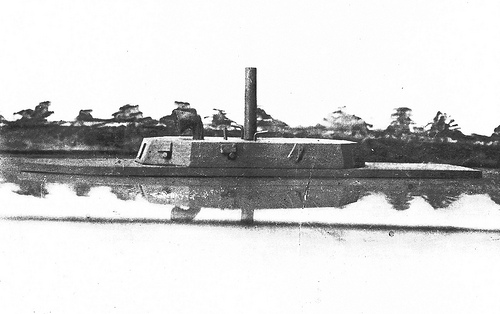Ironclads
See also: Albemarle, CSS; Neuse, CSS; North Carolina, CSS; Raleigh, CSS; Wilmington, CSS.
 Ironclads were warships designed to be impervious to enemy shot and shell by virtue of their iron-armored wooden hulls. Other names for these ships include rams, armorclads, iron gophers, iron elephants, iron coffins, turtle-backs, and mud-crushers. Attempts to armor war vessels had been made during the 300 years prior to the American Civil War, but it was not until the mid-nineteenth century that steam-powered warships and the development of large-caliber rifled cannons made armoring practical and indeed necessary. The Civil War clearly demonstrated the superiority of ironclads and revolutionized naval warfare.
Ironclads were warships designed to be impervious to enemy shot and shell by virtue of their iron-armored wooden hulls. Other names for these ships include rams, armorclads, iron gophers, iron elephants, iron coffins, turtle-backs, and mud-crushers. Attempts to armor war vessels had been made during the 300 years prior to the American Civil War, but it was not until the mid-nineteenth century that steam-powered warships and the development of large-caliber rifled cannons made armoring practical and indeed necessary. The Civil War clearly demonstrated the superiority of ironclads and revolutionized naval warfare.
The Confederacy concluded in June 1861 that ironclad warships would best suit its needs. With its limited shipbuilding capacity, the Confederate navy found it more advantageous to build a few impregnable warships to combat the numerically superior Union navy. The first Confederate attempt was the CSS Virginia, a conversion of the Union frigate Merrimack that had been burned at Gosport Navy Yard when Union forces abandoned the Norfolk, Va., area. Although slow and able to operate only in deep water, the Virginia proved a resounding success. In March 1862, in Hampton Roads, Va., the brand-new ironclad set out to destroy the entire Union blockading squadron. On the first day of fighting, the Virginia handily dispatched two wooden Union vessels. The rest were saved from certain destruction on the second day by the appearance of the Federal ironclad Monitor. The two impregnable ships fought to a draw, but the Virginia's defeat of two wooden warships confirmed the preeminence of armorclad vessels.
Construction of a dozen or more Confederate ironclad gunboats, rams, and floating batteries was begun in North Carolina during the war. Most of them were not completed, including the Wilmington. There would have been many more had not most of the state's larger coastal towns fallen early in the war. The paucity of Confederate records makes identifying these vessels difficult. However, four ironclad rams were commissioned and finished in North Carolina. They were the North Carolina and Raleigh, built in Wilmington on the Cape Fear River; the Neuse, built at Whitehall and completed at Kinston on the Neuse River; and the Albemarle, built at Edwards Ferry and completed at Halifax on the Roanoke River. Considering North Carolina's lack of maritime industries or a major prewar port, the state made a substantial contribution to the Confederate navy's ironclad fleet.
At least two ironclad floating batteries were converted from existing lightships. The Frying Pan Shoals lightship was being converted to a floating battery in the rear of Fort Caswell, near the Western Bar Inlet of the Cape Fear River, when a party from the Union ship Mount Vernon burned it in late December 1861. The Arctic was converted in 1863 and later used as a receiving ship for the Wilmington Station. In March 1863 and January 1865 the Union navy reported Confederate ironclad sightings, but there is no documentation to confirm either account.
Union ironclads were also associated with North Carolina. The USS Monitor sank off Cape Hatteras on 31 Dec. 1862. The following Union ironclad vessels took part in the 24-27 Dec. 1864 and 12-15 Jan. 1865 attacks on Fort Fisher: the single-turreted monitors Canonicus, Dictator, Mahopac, Saugus, the double-turreted monitor Monadnock, and the ironclad warship New Ironsides.
After the Civil War, there was little need for ironclad vessels. Few of the ships were seaworthy, and those only barely so. The majority were scrapped for iron. In the late nineteenth century improvements in the steelmaking process ended the need for ironclad vessels. Rather than using a wooden hull with armor only above and a few feet below the waterline, the entire ship could be made from steel. Nonetheless, ironclads were a crucial innovation in the history of naval warfare.
References:
Leslie S. Bright, William H. Rowland, and James C. Bardon, C.S.S. Neuse: A Question of Iron and Time (1981).
Robert G. Elliott, Ironclad of the Roanoke: Gilbert Elliott's Albemarle (1994).
Paul H. Silverstone, Warships of the Civil War Navies (1989).
William N. Still Jr., Iron Afloat: The Story of the Confederate Armorclads (1985).
Image Credit:
"CSS Neuse Confed Gun Boat. Model of the CSS Neuse." From the General Negative Collection, North Carolina State Archives, Raleigh, NC. Call #:N_64_1_184. Available from https://www.flickr.com/photos/north-carolina-state-archives/4273502731/ (accessed May 15, 2012).
1 January 2006 | Harris, Henry